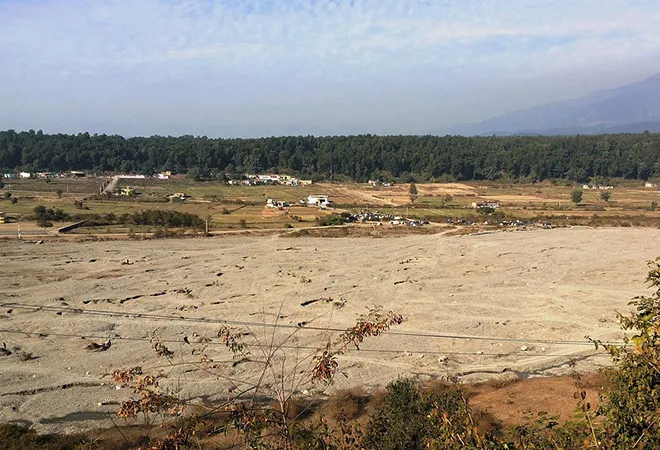-
CENTRES
Progammes & Centres
Location

Being an environment and development economist, one keeps advocating that India needs to evolve with a new development paradigm that will account for the impact on our ecosystem and the natural resource base. The existing reductionist ‘growth-fetishism’ of the Indian economy, nurtured over the last seven decades, is definitely not sustainable.
Leading up to the parliamentary election 2019, one has been reading the election manifestos of different parties in search of whether a new development paradigm can emerge with a more holistic vision if the concerned party comes to power. Here, we can compare whether and how election manifestos of four parties articulate pointers of the new development paradigm that is akin to ‘green economic development’.
These parties include the two big players in national politics, the Bharatiya Janata Party (BJP) and the Indian National Congress (INC), the Left represented by the Communist Party of India (Marxist), and closer home in West Bengal, the Trinamool Congress (TMC). At the very outset, it needs to be admitted that all the four manifestos talk about environment and climate change. In context of the inextricable linkage of climate change, natural resource depletion, and environmental degradation with economic development, the INC manifesto is the only one to have a statement on a “comprehensive land and water use policy”.
This is indeed a forward-looking policy statement in the current scenario. It also mentions another important aspect of the new development paradigm, where the INC intends to “present the national accounts in a form that will account for the costs of environmental degradation and damage. The annual budget will adopt the core principles of green budgeting.” This is a major call for change from the reductionist ways in which development has been looked at so far in terms of activities in the formal economic set-up.
On the one hand, there will be accounting for the costs of growth, thereby reporting on how much resource base for future growth gets impeded. At the next level, there has to be a call for valuation the free-of-cost services provided to the human community by the ecosystem. Human growth ambitions often impede ecosystem services, and dent human well-being. Capturing these costs in the framework of national income accounts and annual budget could link up two ministries that work in silos: finance and, environment and forest; and bring in others like the ministries of water, agriculture, rural development, etc, to the holistic development paradigm. Other ministries will then have more say in creating an integrated sustainable development strategy for the nation.
Both the INC and the BJP, however, have talked of an integrated approach to water governance. Both have mentioned that all water-related governance and management issues will be brought under one authority. This is definitely the need of the hour! So far, an integrated basin-level approach to water governance has been missing in India. A fragmented approach to water governance is the genesis of all the problems including water conflicts. Yet, the statement on ‘linking rivers from different parts of the country’ in the BJP’s manifesto is definitely not part of the solution, but a major problem. The problems of river interlinking were highlighted in a previous column in these pages — the very basis of transferring water from ‘surplus’ to ‘deficit’ basins is scientifically flawed, economically infeasible, socially undesirable and ecologically disastrous.
Rather, if voted to power, the BJP will do well if it indeed acts on the two critical documents that appeared in public forum during its rule and work on their recommendations — National Water Framework Bill (NWFB), 2016, and the July 2016 report titled A 21st Century Institutional Architecture for India’s Water Reforms. Both were drafted under the chairmanship of Dr Mihir Shah and have been forgotten ever since. These two landmark documents call for a radical change towards integrated water governance much in consonance with the new development vision that one would like to see India embark on.
The CPI(M) manifesto is well researched on its economic aspects, though there are elements that as an economist one may disagree with — increasing the securities transaction tax or doing away with long term capital gains on equity returns — both of which could drive away foreign institutional investor from the capital markets. Barring this ideological position, however, the significant statement that they make in their manifesto is related to “climate-resilient development.” While this by itself is extremely important, it does not fully represent the new development paradigm. Neither does the TMC’s manifesto make any major statement on this aspect. It seems to be heavily based on proclaimed state-level achievements instead of presenting a broader national vision of holistic development that takes care of the temporal and spatial concerns of development governance. As such, all the manifestos have their own strengths and weaknesses on grounds of economy, defence, foreign relations, society and culture, social security, or overall governance, that can broadly be classified into various sustainable development goals.
This commentary originally appeared in Mail Today.
The views expressed above belong to the author(s). ORF research and analyses now available on Telegram! Click here to access our curated content — blogs, longforms and interviews.

Dr Nilanjan Ghosh is Vice President – Development Studies at the Observer Research Foundation (ORF) in India, and is also in charge of the Foundation’s ...
Read More +